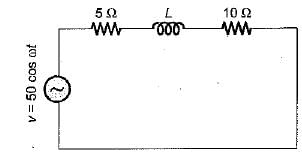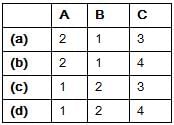Test: Basic & Electric Circuits- 2 - Electrical Engineering (EE) MCQ
20 Questions MCQ Test Topicwise Question Bank for Electrical Engineering - Test: Basic & Electric Circuits- 2
A current of 3 A flows through a resistor of 20 ohms. The energy dissipated in the resistor per minute is
A long uniform coil of a inductance L henries and associated resistance R ohms is physically cut into two exact halves which are then rewound in parallel. The resistance and inductance of the combination are
In the circuit shown, the power dissipated in the resistor R is 1 W when only source ‘1’ is present and ‘2’ is replaced by short circuit. The power dissipated in the same resistor R is 4 W when only source '2’ is present and '1' is replaced by a short circuit When both the sources ‘1’ and ‘2’ are present, the power dissipated in R will be


If v, w, q stand for voltage, energy and charge, then v can be expressed as:
In the figure shown below, φ = power-factor angle, W = watts, VA = volt ampere and VAr = volt-ampere .reactive for an ac circuit. The correct figure is
A circuit possesses resistance R and inductive reactance XL in series, its susceptance is given by
If V = a + jb and I = c + jd, then the power is given by
A 230 V, 100 W bulb has resistance RA and a 230 V, 200 W bulb has resistance RB. Here,
1. RA > RB
2. RB > RA
3. RA = 2 RB
4. RB = 2 RA
5. RA = 4 RB
From these, the correct answer is
The voltage phapor of a circuit is 10∠15° V and the current phasor is 2∠- 45° A. The active and the reactive powers in the circuit are
In the circuit shown below, if the power consumed by the 5 Ω resistor is 10 W, then power factor or the circuit will be

The minimum requirements for causing flow of current are.
For a fixed supply voltage, the current flowing through a conductor will increase when its
Two registors R1, and R2 give combined resistance of 4.5 Ω when in series and 1 Ω when in parallel. The resistances are
Which of the following is not equivalent to watts?
Two heaters, rated at 1000 W, 250 V each are connected in series across a 250 V, 50 Hz ac mains. The total power drawn from the supply would be
A 100 watt light bulb burns on an average of 10 hours a day for one week. The weekly consumption of energy will be
Assertion (A): The direction of flow of conventional current is taken opposite to that of electrons.
Reason (R): Electrons have negative charge.
Match List-I (Materials) with List-lI (Range of resistivity) and select the correct answer using the codes given below the lists:
List-I
A. Conducting materials
B. Semiconductor materials
C. insulating material
List-II
1. 100 to 102 Ω-m
2. 10-8 to 10-6 Ω-m
3. 1012to 1018 Ω-m
4. 1020 to 1030 Ω-m
Codes:

A constant current source supplies a current of 200 mA to a load of 2 kΩ When the load is changed to 100 Ω, the load current is





































 ...(ii)
...(ii)












